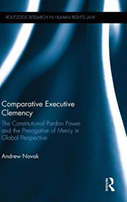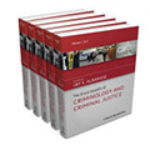Comparative Executive Clemency: The Constitutional Pardon Power and the Prerogative of Mercy in Global Perspective

Author: Andrew Novak
Publisher: New York, NY: Routledge, 2016. 198 pp.
Reviewer: Mark Osler | January 2017
In the middle of reading Comparative Executive Clemency, I received a call from the United States Pardon Attorney’s office. They gave me a thrilling and unusual directive: I was to reach out to three of my pro bono clients, all serving life terms, and tell them that the President had granted them clemency. I called each in turn and gave them the remarkable news that the most powerful person in the world had read their petitions and deemed them worthy of mercy. Their reactions ranged from calm, deep joy to a stunned silence.
Those moments in our own recent history—from Ford’s pardon of Nixon to the release of crack offenders under President Obama’s clemency initiative– are emotional and significant, and sometimes cut through the rest of our criminal law doctrines like a sharp machete through cane. Andrew Novak’s book does not obscure the deep currents that run within this ancient institution of clemency. For example, early on he recognizes that the “prerogative of mercy descends from a paradox of modern law: the law provides for strict personal liability for broadly-defined offenses, yet officials needed to accommodate human frailty and criminal deviance in order to maintain the public’s respect for the law.” (p. 19). That’s a good statement of just one of the inherent tensions that make clemency such a fascinating subject of examination.
Novak’s focus is global — and that is a challenging task to undertake within the pages of a single volume. He begins with a historical analysis centered on England and its colonies, which likely includes the homes of a majority of his potential readers. Ambitiously, he moves on to cover the entire world, though the majority of his analysis looks to jurisdictions with some degree of British influence. Because the book is structured by topic (e.g., “scope of the pardon power”) rather than geographic region, this necessitates a good deal of skipping around the globe in quick succession. In just one page (p. 101), a discussion of the ability of an executive to grant pardons before conviction begins with a few sentences about Tonga and then jets off to the United States, New Zealand, Samoa, South Africa, Malta, Nigeria, South Africa, Bangladesh, and a number of exotic British overseas dependencies. At times, I wished for more explication of how diverse jurisdictions came to similar constructions of clemency– was it a common British heritage, or some other influence?
The issues chosen for attention are compelling. Chapter Three delves into international law and practice, centered on still-developing institutions such as the European Court of Human Rights. Chapter Four examines constitutional frameworks for clemency, revealing a diverse set of structures ranging from an unchecked power resting with the executive to a board or committee that acts on its own authority. Chapter Five unpacks the scope of the pardon power in various nations, while Chapter Six describes the work of “mercy committees,” a construct found in the British-influenced nations of the world and particularly within the British Commonwealth. Chapter Seven compares the discrete procedures employed in various nations (a broad topic that probably should have incorporated the mercy committees of the previous chapter), while Chapter Eight lays out the legislative and judicial review allowed in several countries.
More than anything, the book projects the very true idea that mercy through legally established clemency is a legal construct that exists in a stunning array of places. The focus on former British colonies, though, means that there are some gaps in the title’s claim of a “global perspective.” Hong Kong receives a fair amount of attention, but the 1.3 billion people of China only get a passing notice, recognizing that “the country does not have a formal clemency mechanism in death row cases” (p.52). A truly global perspective on clemency probably requires some examination of why the world’s most populous nation doesn’t currently embrace that ideal—in fact, that is the main question I came away with when I finished the book. The contrast is stark, too; when giving a lecture in Guangzhou last year, I found that each time I used the word “pardon” or “clemency” it was interpreted as “corruption.” Left unexamined is the question of whether clemency was lost during the Communist Revolution or the Cultural Revolution, or simply never existed within the Chinese governments of the past thousand years of recorded history.
Some major industrialized nations without a British influence escape the book’s attention entirely. South Korea is unmentioned, though it has gone through a wrenching political debate in recent years over the use of the pardon power to free white collar criminals. It is unfair, of course, to expect 200 pages to encompass thoroughly all of the world’s nations. I don’t mean to imply that this is a bait-and-switch; though the title does not reflect it, Novak’s introduction and opening chapters do accurately identify and foreshadow the centrality of British-influenced states (or the “common law world”) to his analysis.
For the scholar of clemency, Novak’s work is worthwhile and clearly set out. Chapter Three tackles the role of clemency in international law, addressing actions under the International Covenant on Civil and Political Rights, the American Convention on Human Rights, the American Declaration on the Rights and Duties of Man, and the European Convention on Human Rights. Fortunately, certain core principles and questions recur nearly universally in this field, allowing a relatively quick survey of a diverse welter of laws and courts to be understandable, if not comprehensive.
One of those core questions, revisited appropriately throughout the book, is the role of the death penalty. Novak frames the entire trajectory of clemency in terms of capital punishment, and he is right to do so; as the number of nations using the death penalty diminishes, so does the primary driver of clemency in many of those nations (p. 5). That broad insight is well substantiated and further examined in a number of later chapters before an explicit restatement at the end of Chapter Seven (pp. 166-169). Death and mercy at the hands of the state, it seems, are strangely yoked together.
Novak’s primary sources on theory and practice (including Austin Sarat and Jeffrey Crouch) are well-chosen. Once you get past the introductories and into the heart of the book, theory takes a back seat to procedure in most of the chapters, which makes sense. To constantly unpack theory as applied to any one jurisdiction would slow the book’s primary project of contrasting and comparing what actually happens in diverse jurisdictions. Of course, theory that goes any deeper than expressions of retribution or mercy may be hard or even impossible to discern in far-flung nations separated by barriers of language, culture, and colonial histories.
As one might expect from the author’s background (Novak was trained in Washington, Boston and London), the analysis seems most coherent when it addresses British and American law. At times, he seems to discuss practices in Missouri or Texas as if they are as distinct and organic as what he finds in Malawi, and he isn’t wrong to do so. The unique structure of state laws in the U.S. invites this analysis.
Upon finishing the book, I found myself longing not for more theory, but for more insight into nations (like China and South Korea) that don’t share some kind of British heritage. It would also have been worthwhile to include an end-to-end examination of a few jurisdictions, simply to see how the various parts (constitutional authority, procedure, and legislative or judicial review) fit together and contrast. Novak is doing more work in this area and will likely give me what I desire in subsequent books. He is not to blame for my greed!
Our American experience over the past several decades has not cast clemency in a good light. People remember the trauma of Watergate and the Nixon pardon, or Bill Clinton’s reprehensible pardon of Marc Rich, or (if they were born more recently) don’t think about it much at all since the constitutional pardon power has not been actively used for much of their lives. President Obama’s clemency initiative– which has freed hundreds of narcotics prisoners serving lengthy terms– has brought the issue back to national attention and offers the promise of a return of clemency to a place of value within our legal system. As Novak sets out, clemency is not a new or novel part of the American legal structure. Rather, it flows from millennia of human experience, and is intricately entwined with our most subtle virtues and brutal instincts. It could be that the decline of the death penalty is not necessarily going to close the door on clemency; the institutional virtue of mercy runs both deeper and broader than that, to sentences other than death and to nations far from our shores.


